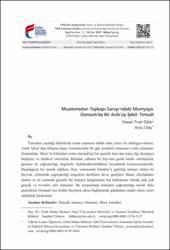| dc.contributor.author | Diker, Hasan Fırat | |
| dc.contributor.author | Ulaş, Arzu | |
| dc.date.accessioned | 2019-06-28T08:59:36Z | |
| dc.date.available | 2019-06-28T08:59:36Z | |
| dc.date.issued | 2019-06 | |
| dc.identifier.citation | DİKER, Hasan Fırat & Arzu ULAŞ. "Muammadan Topkapı Sarayı’ndaki Mumyaya,Osmanlı’da Bir Acîb’üş-Şekil: Timsah." FSM İlmî Araştırmalar İnsan ve Toplum Bilimleri Dergisi, 13 (2019): 187-210. | en_US |
| dc.identifier.uri | https://dergipark.org.tr/fsmia/issue/46340/582351 | |
| dc.identifier.uri | https://hdl.handle.net/11352/2863 | |
| dc.description.abstract | Timsahın yaşadığı iklimlerde insan yaşamını tehdit eden yırtıcı bir sürüngen olması,
Antik Mısır’dan itibaren inanç sistemlerinde bir güç sembolü olmasına vesile olmuştur.
Osmanlılar, Mısır’ın fethinden sonra tanıştıkları bu egzotik hayvana karşı ilgi duymaya
başlamış ve merkezi otoritenin iklimine yabancı bu hayvanı gerek kendi varoluşuyla,
gerekse de çağrıştırdığı imgelerle ilişkilendirebildikleri boyutlarda benimsemişlerdir.
Başlangıçta bir merak şahikası iken, sonrasında İstanbul’a getirilip temaşa edilen bu
hayvan, zihinlerde çağrıştırdığı imgelerle dertlilere deva, gemilere ilham, çikolatalara
marka ve en sonunda gizemli bir mumya kurgusunun baş kahramanı olarak, pek çok
gerçek ve tevatüre alet olmuştur. Bu araştırmada timsahın çağrıştırdığı merak dolu
gizemlerin Osmanlı’nın kültür hayatına etkisi bağlamında günümüze kadar süren izleri
sürülmek istenmiştir. | en_US |
| dc.description.abstract | Threatening the life of mankind as a predator reptile in its habitual regions caused
crocodiles to be a symbol of power in belief systems since Ancient Egypt. Ottomans were
very interested in this exotic animal, which they met after the conquest of Egypt, and
although it was foreign to the climate of central authority, they adopted it both with its
own existence and the images it reminded within the aspects they could associate with. As
it was the peak of wonder itself at the begining, crocodiles were later brought to Istanbul
to be exhibited, and with the images they inspired, they became motifs in many facts and
fictions such as remedies for sufferings, inspiration for ships, marks for chocolates and
finally, the leading actor of a mystery mummy fiction. This study aims to following the
traces of the wondrous mysteries evoked by crocodiles within the context of their effects
to Ottoman cultural life, still present today. | en_US |
| dc.language.iso | tur | en_US |
| dc.publisher | FSM Vakıf Üniversitesi | en_US |
| dc.rights | info:eu-repo/semantics/openAccess | en_US |
| dc.subject | Timsah | en_US |
| dc.subject | Mumya | en_US |
| dc.subject | Osmanlı | en_US |
| dc.subject | Mısır | en_US |
| dc.subject | İstanbul | en_US |
| dc.subject | Crocodile | en_US |
| dc.subject | Mummy | en_US |
| dc.subject | Ottoman | en_US |
| dc.subject | Egypt | en_US |
| dc.subject | Istanbul | en_US |
| dc.title | Muammadan Topkapı Sarayı’ndaki Mumyaya, Osmanlı’da Bir Acîb’üş-Şekil: Timsah | en_US |
| dc.title.alternative | From Mystery to the Mummy in Topkapı Palace, a Strange Figure in Ottomans: Crocodile | en_US |
| dc.type | article | en_US |
| dc.contributor.department | FSM Vakıf Üniversitesi, FSM İlmî Araştırmalar İnsan ve Toplum Bilimleri Dergisi | en_US |
| dc.relation.publicationcategory | Makale - Ulusal Hakemli Dergi - Kurum Öğretim Elemanı | en_US |



















